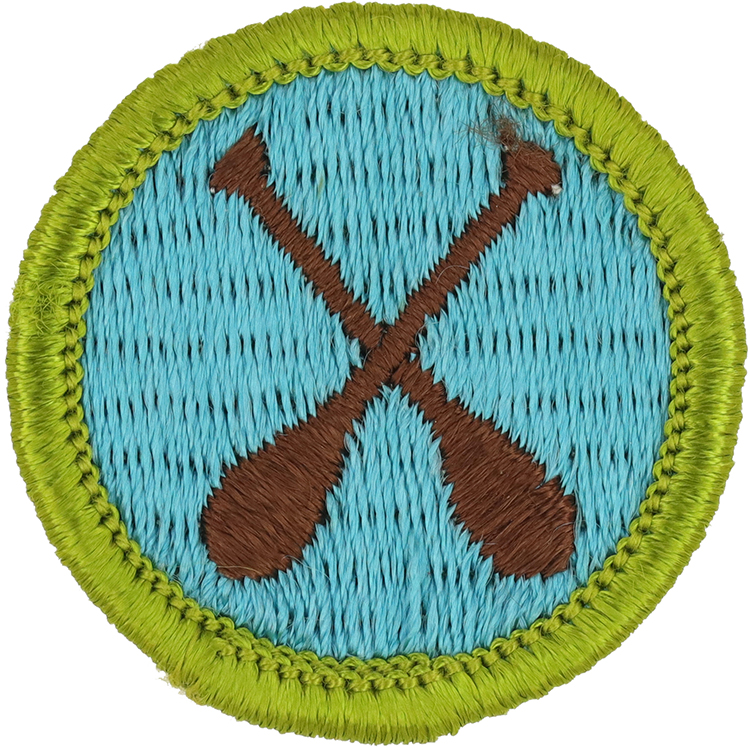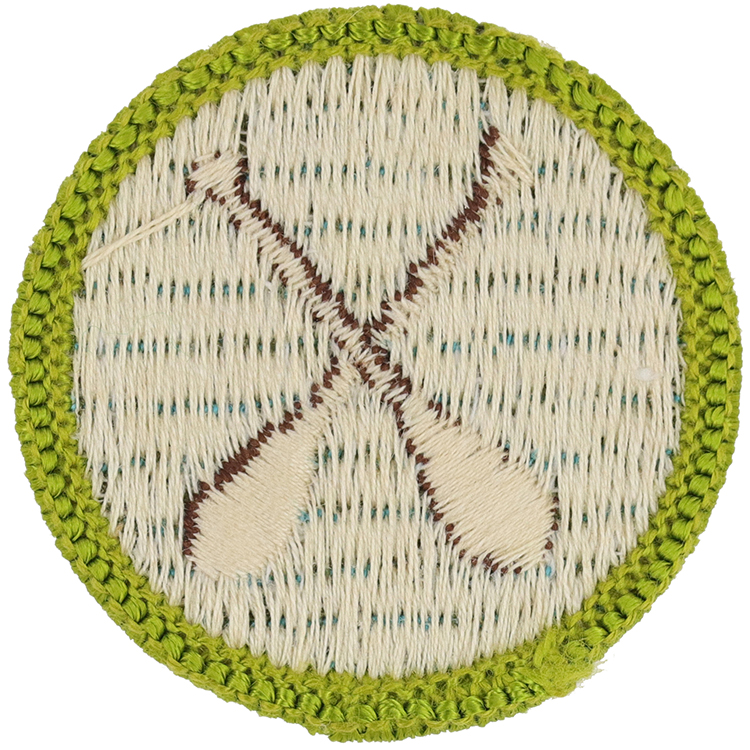
Fig. 1: Canoei-G-Front
- Embroidery: Cotton thread
- Border: Merrowed

Fig. 2: Canoei-G-Reverse
- Back: Starched cloth
Item Name: Canoeing 1969 - 1972
Item ID: Canoei-G
Collector Rating: 1
Requirements January 1969 until June 1972
Complete First Class Test 8.
1. Demonstrate your ability to swim 100 yards as follows:
Swim 75 yards in a strong manner using any stroke or strokes and swim 25 yards on your back using an easy resting stroke; rest by floating (or if not buoyant, with a minimum of motion).
2. On the canoe and paddles used to meet these requirements, point out and name each part.
3. With a companion about your own weight and using a properly equipped canoe not less than 14 feet in length:
a) Launch and get in the bow of the canoe properly from pier or shore (both, if possible), giving directions to your companion.
(b) Paddle 100 yards using a single-blade paddle while kneeling on one or both knees. Turn and paddle back, showing proper form in the following strokes: bow, diagonal draw, pushover, backwater, reverse sweep, quarter sweep, stop.
(c) Change paddle to other side and repeat Requirement 3b.
(d) Change places with your companion while your canoe is afloat. On one or both knees, in the stern, paddle 100 yards and return, showing ability to keep canoe on a straight course.
(e) Make a proper landing at pier and shore.
4. While alone in canoe:
(a) Demonstrate eight single-blade strokes: (a) J, (2) draw, (3) stop, (4) pushover, (5) sweep, (6) reverse, (7) scull, (8) outside pivot.
(b) Complete five circuits of a short, irregular course marked by buoys, paddling on one side only, demonstrating knowledge of weight location in the canoe (trip and heel), and using suitable strokes for efficient completion of the course.
(c) Using single-blade or double-blade paddles, paddle over a 100-yard straight course and return using suitable strokes for efficient completion of the course.
5. While fully dressed and alone in a canoe, do the following:*
(a) Vault into the water feet first, keeping hold of the canoe with one hand; then climb back into the canoe without shipping water.
(b) Capsize the canoe in deep water about 50 yards from a landing place, then
(c) Right the canoe and stow paddle and kneeling pad. Get in the swamped canoe and paddle with hands (or with paddle) for 25 yards.
(d) Go overboard, and holding with one hand, swim and tow (or swim and push) the canoe to shore.
(e) Empty the canoe and store it properly with assistance if necessary.
6. With a companion and in the bow, assist tow persons who have capsized their canoe and are clinging to it. Empty the swamped canoe properly over your own canoe and steady it while they climb aboard.
7. Discuss with your counselor:
(a) Canoe trip preparations and safety.
(b) How to repair a hole or break in a canvas-covered canoe, an aluminum canoe, and a fiber-glass canoe.
(c) Other uses of the canoe such as racing and sailing.
(d) Explain lining and poling; also differences between lake canoeing and river canoeing.
*Wear clothing usually worn in canoeing in your territory according to the season of the year.
First Class Test
8. Do one of the following:
(a) Tell what precautions must be taken for a safe swim.
(b) Jump feet first into water over your head in depth. Swim 50 yards. During the swim, stop, make a sharp turn, and resume swimming.
If a physician certifies that the Scout's physical condition for an indeterminable time does not permit the First Class swimming, the Scoutmaster and troop committee chairman may recommend substitutions as specified on Application for Substitution for Basic Scout Requirements, No. 4434. This application must be approved by the council advancement committee.


